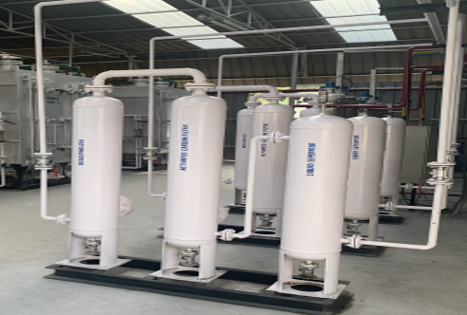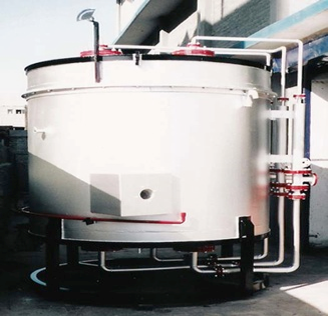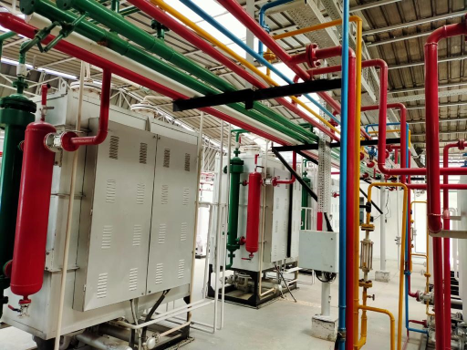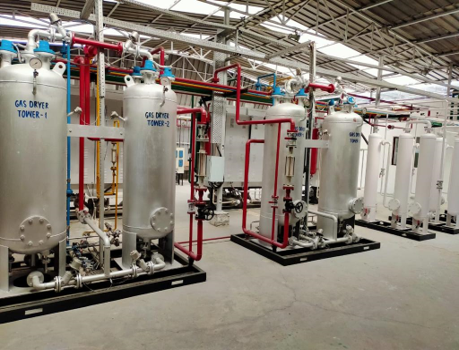
On-site Hydrogen from Ammonia Reforming
Absolut offers globally acclaimed cost-effective hydrogen gas on-site plants based on vapor ammonia dissociation with further purification through zeolites to produce pure hydrogen.
Absolut offers equipment for generation of hydrogen enriched gas mixtures by dissociation of ammonia molecules. Such equipment produces a mixtures of three parts of hydrogen and two parts of nitrogen. Since nitrogen is basically inert in nature, these mixtures are widely accepted as pure hydrogen in a number of applications.
For further pure hydrogen, such hydrogen nitrogen mixtures can further be processed to generate hydrogen up to 99% purity, deploying the PSA adsorption systems.
Such systems are widely utilized in Glass Industry and Heat Treatment especially for Bright Annealing and Brazing Lines, apart from other hydrogen applications.

Hydrogen Plants from Ammonia Dissociation – perfect fit for Stainless Steel Annealing and Float Glass applications
Since the hydrogen produced from this mode of ammonia dissociation, is a unique mixture of 75% hydrogen and 25% nitrogen, it is a popular choice in stainless steel annealing as the atmosphere inside the furnaces requires both nitrogen as well as hydrogen.

Similarly, the hydrogen from such technology, is a direct fit in float glass industry as the tin bath atmosphere required is again a mixture of nitrogen and hydrogen.
Based on the specific requirements, the flow of this mixture is modulated with pure nitrogen, to achieve desired reducing atmospheres.
The Ammonia Dissociation Process
Ammonia (NH3) stoichiometrically has three parts of hydrogen and one part of nitrogen. For its dissociation, energy and presence of a catalyst is essential.




01. Raw Ammonia Pre-treatment
Raw ammonia from bottles or tank, is first treated in three stages; physical liquid moisture separation, and two stages of desulphurisation. This is to ensure that no sulphur residue remains in ammonia before it reaches the dissociation stage.
02. Dissociator Furnace
The pre-treated ammonia is then passed into an alloy cast tube contained in a high temperature furnace. The tube is filled with highly efficient nickel catalyst. In presence of the catalyst and at about 1000 Deg C, ammonia is dissociated into its component molecules.
The furnace energy source can be electricity or gaseous fuel like LPG or Natural Gas.
03. Gas Mixture Purifier and Dehumidifier
The gas mixture is further treated to become usable for the application. After the furnace the gas is at a high temperature, moisture, and with having some residual ammonia content.
The treatment is based on a twin tower zeolite molecular sieves, wherein the residual ammonia and moisture is adsorbed with special mix of grades of zeolites. The gas mixture leaving the treatment skid is having a guaranteed residual ammonia of Zero PPM and moisture content as low as (-) 90 Deg C atmospheric dew point.
04. Product Delivery
The hydrogen rich gas mixture is then sent to the hydrogen receiver tank for the further consumption.
Plant General Specifications
Absolut Air provides following boundary conditions to on-site Hydrogen Solutions based on Ammonia Dissociation :
| Flow Rates | H2 Purity | Nitrogen | Pressure |
|---|---|---|---|
| 1 to 500 Nm3/hr | 75% to 99% | 25% to 1% | 0.5 to 7 Kg/cm2g |
| Atm. Dew Point | Temperature | Power |
|---|---|---|
| (-) 70 to (-) 100 Deg C | Ambient | 415 V, 3 Phase, 50 Hz |
| Specific Power | Electricals | Noise Levels |
|---|---|---|
| From 0.5 kWh/Nm3 (0.5 Kg/cm2g) to 1.0 kWh/Nm3 (3.5 Kg/cm2g) | Standard wiring and controls, as per international industrial standards. | 40 dBA time weighted average at 1 meter, in free field area. |
| Quality | Pressure Piping | Pressure Vessels |
|---|---|---|
| Absolut Air meets ISO 9001, and follows established engineering procedures. | Conforms with ANSI B3.1.1, Schedule 40, Fittings as per ANSI B16.9; Flanges as per ANSI B16.5. Other codes satisfied if required. | Designed and fabricated as per ASME Sec VIII Div I |
Further Purification of 99% Pure Hydrrogen
The gas mixture of 75% hydrogen and 25% nitrogen, if some applications require, can be further processed with nitrogen adsorption systems, to generate about 99% pure hydrogen.

PSA Hydrogen Process
This purification uses the same PSA technology for nitrogen adsorption as in production of oxygen from air.
The gas mixture of 75% hydrogen and 25% nitrogen, when passed through a twin bed PSA process with nitrogen adsorption zeolite molecular sieves, the nitrogen is effectively adsorbed, generating a continuous stream of 99% pure hydrogen.
The process uses special grade of Zeolites from CECA, France / UOP, USA, with high degrees of efficiencies. The moisture content in such hydrogen is as low as 5 PPM.
Uses of such hydrogen is in Metallurgical, Heat Treatment, Brazing, Sintering, and other hydrogen applications.
Raw Anhydrous Ammonia Storage and Vaporisation
The ammonia to be dissociated can either be stored in ammonia bottles with suitable manifold systems, or in bulk ammonia storage tanks, complete with the vaporisation equipment, to deliver continuous flow of anhydrous vapour ammonia to the hydrogen generating module.

Absolut Air Hydrogen systems offer setting up of bulk Ammonia storage installation, which is complete in all respects as per guidelines from the Chief Controller of Explosives.


The raw liquid ammonia vaporization systems are offered both by atmospheric or electrically heated, or both depending upon the site conditions.
Features and Benefits
- Special European / US grade of Zeolites used for dehumidifying or purifying hydrogen.
- Hydrogen levels of 95-99% are achieved on continuous basis.
- Cost Effective and Efficient method of generating on-line hydrogen.
- Widely used in Brazing and other Metallurgical Furnace applications.
- Hydrogen Pressures achieved ias high as 7 Kg/cm2g.
- Storage of such hydrogen offered for peak requirements.
- LPG /NG Fired or Electrically Fired Furnace options available.
- Hydrogen mixture dew point as low as (-) 1000 Deg C.
- Ammonia Analyzer measures on-line residual ammonia in the product.

